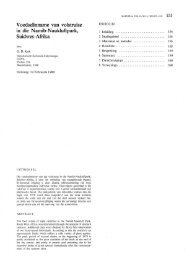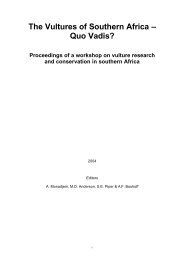Demarcation of Water Basins on National Level - EIS
Demarcation of Water Basins on National Level - EIS
Demarcation of Water Basins on National Level - EIS
Create successful ePaper yourself
Turn your PDF publications into a flip-book with our unique Google optimized e-Paper software.
Basin <str<strong>on</strong>g>Demarcati<strong>on</strong></str<strong>on</strong>g><br />
Delta. It is therefore recommended to combine the to catchments into <strong>on</strong>e basin because developments<br />
in either catchment will have a direct impact <strong>on</strong> the development <str<strong>on</strong>g>of</str<strong>on</strong>g> the other.<br />
However, for management purposes it is proposed to subdivide the basin into two sub-basins, i.e. the<br />
Omaruru-Lower Swakop Basin and the Upper Swakop-Upper Omatako Basin. The Omatako Dam is<br />
an important source <str<strong>on</strong>g>of</str<strong>on</strong>g> the Windhoek water supply scheme and the upper catchment <str<strong>on</strong>g>of</str<strong>on</strong>g> the Omuramba<br />
Omatako was integrated into the basin. The Dolomite Karst Aquifer <str<strong>on</strong>g>of</str<strong>on</strong>g> the Grootf<strong>on</strong>tein Area is part <str<strong>on</strong>g>of</str<strong>on</strong>g><br />
the Kavango-Omatako Basin but is an emergency water supply source for the central regi<strong>on</strong>, i.e. the<br />
Swakop-Omaruru Basin. The Karst Area is c<strong>on</strong>nected to the central area by the Eastern <str<strong>on</strong>g>Water</str<strong>on</strong>g> Carrier<br />
network. Existing and planned groundwater abstracti<strong>on</strong> schemes area situated at Kombat Mine, Berg<br />
Aukas Mine and in the Abenab Mine area. A close co-operati<strong>on</strong> between the management committees<br />
<str<strong>on</strong>g>of</str<strong>on</strong>g> both important basins is required for the optimal utilisati<strong>on</strong> <str<strong>on</strong>g>of</str<strong>on</strong>g> the groundwater resources and the<br />
sustainable water supply to the central regi<strong>on</strong>s.<br />
2.10.3. Infrastructure, Socio-Ec<strong>on</strong>omic and Cultural Units<br />
The Rössing Uranium Mine is <strong>on</strong>e <str<strong>on</strong>g>of</str<strong>on</strong>g> the main single c<strong>on</strong>sumers in the basin and is resp<strong>on</strong>sible for the<br />
development <str<strong>on</strong>g>of</str<strong>on</strong>g> the Omaruru Delta. The opening <str<strong>on</strong>g>of</str<strong>on</strong>g> a new uranium mine at Langer Heinrich is in an<br />
advanced stage and Nam<str<strong>on</strong>g>Water</str<strong>on</strong>g> shall supply water via pipeline also from the Omaruru Delta scheme.<br />
The demand is in the range <str<strong>on</strong>g>of</str<strong>on</strong>g> 1 – 1.5 Mm 3 /annum. The new mine development is situated at the<br />
southern margin <str<strong>on</strong>g>of</str<strong>on</strong>g> the basin, <strong>on</strong> the water divide between the Swakop and Kuiseb rivers.<br />
Future development might include seawater desalinati<strong>on</strong> to supplement the water supply to the coastal<br />
area. Another possible scenario is the c<strong>on</strong>structi<strong>on</strong> <str<strong>on</strong>g>of</str<strong>on</strong>g> a bulk water pipeline to the Okavango River to<br />
supply water to the central regi<strong>on</strong>s. The pipeline, which transports water from the Swakoppoort Dam<br />
to Karibib and the Navajab Gold Mine could then be extended to the Rössing Mine and the water<br />
could be gravitated through the existing pipeline to Swakopmund. In all cases the entire basin is<br />
affected and the co-operati<strong>on</strong> between authorities and stakeholders is required.<br />
2.11 KUISEB BASIN<br />
2.11.1. Physiographic Parameters<br />
The Kuiseb Basin was the first basin in Namibia to be investigated in terms <str<strong>on</strong>g>of</str<strong>on</strong>g> the newly developed<br />
basin management principles and a basin pr<str<strong>on</strong>g>of</str<strong>on</strong>g>ile involving all relevant stakeholders was carried out in<br />
the previous years. The basin delimitati<strong>on</strong> was based mainly <strong>on</strong> the surface catchment <str<strong>on</strong>g>of</str<strong>on</strong>g> the<br />
ephemeral Kuiseb River. The Kuiseb River originates in the Khomas Highland west <str<strong>on</strong>g>of</str<strong>on</strong>g> the capital<br />
Windhoek and flows in a western directi<strong>on</strong> through the escarpment and the desert plain foreland<br />
towards the Atlantic Ocean. The Kuiseb delta south <str<strong>on</strong>g>of</str<strong>on</strong>g> Walvisbay and paleo-channels underlying the<br />
Kuiseb Dune area are included. For this study <strong>on</strong>ly minor changes were effected, for example al<strong>on</strong>g<br />
the southern boundary, where the basin boundary was slightly shifted to coincide with the regi<strong>on</strong>al<br />
border between Er<strong>on</strong>go and Hardap.<br />
2.12 NOSSOB-AUOB BASIN<br />
2.12.1. Physiographic Parameters<br />
The Nossob-Auob Basin comprises the surface catchments <str<strong>on</strong>g>of</str<strong>on</strong>g> the southeast flowing Black and White<br />
Nossob rivers, the Olifants, Seeis, Skaap, Oanob and Auob rivers. The discharge area is the so-called<br />
Stampriet Artesian Basin, where significant groundwater resources are c<strong>on</strong>fined to Karoo Sequence<br />
Bittner <str<strong>on</strong>g>Water</str<strong>on</strong>g> C<strong>on</strong>sult 2004 GTZ, MAWRD<br />
12




